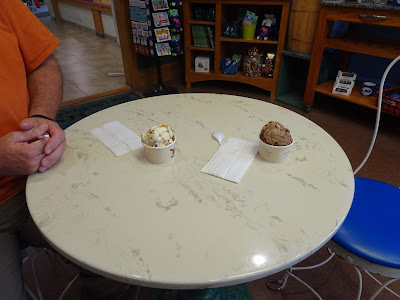We make it a point to visit small local museums when we travel, and were surprised to discover one right under our noses that we've missed in the four months we have been here. The Maine Granite Museum is only about 20 miles south of us, on Mount Desert Island. Mount Desert Island is most famous for being the location of Acadia National Park.
But as early as 1830 Mount Desert Island was known for dozens of granite quarries. Due to a complex history of tectonic plates collisions, volcanic events, sea level changes and glaciation, there are several different types of granite found in this relatively small region.
Map of past quarry locations on Mount Desert Island
Some of the granite found near Bar Harbor
With several different types of rock to choose from, and deep-water ports that allowed ships to load directly from the quarries, Bar Harbor granite made its way to buildings as far away as Omaha, Nebraska.
It is amazing that the building was essentially built in Maine, and then disassembled with each stone marked, and shipped to Nebraska where is was re-assembled. This was the technique used for most of the stone buildings of the era.
The Founder/curator of the museum is Steve Haynes, and he runs the place as a one-man show. Steve began his apprenticeship at the ripe age of 11 years old, completing it in 4 years. He then worked his career as a stone mason on Bar Harbor, unfortunately seeing the decline of the industry and closing of most of the quarries. His goal now is to preserve and present the amazing history of the era.
Steve Haynes with polished granite sphere
from his apprenticeship
We learned that the "final exam" of a Mason's apprenticeship was the creation of a polished granite sphere. Steve mentioned that the process of creating the sphere takes place over a period of two years. He had a variety of spheres on display, including the one that he himself created during his apprenticeship!
One exhibit showed the tools and process used to create a basic granite block.
First, a shallow line is chiseled onto the surface of the block to show the desired cut. Then 3" deep holes were drilled with a hand drill, about 6" apart. The drill is actually a pointed chisel that shatters the hard granite into dust, which is then removed with a tiny little dust spoon.
"Spoon" used to remove granite dust from drill hole.
Once the line of holes is completed a series of wedges is inserted into the hole and tightened. The amount of tension in the wedges is important, as too tight will cause a quick, ragged break. The correct amount of wedging results in a slower, straight break.
Once the basic stone block is split, there is a long process to create perfectly flat faces which are critical to stone building construction. Each corner is worked down until they are all at the same height. Steve demonstrated how it was done with a set of four spacers and two sticks to "eyeball" it the correct height. Once the corners were at the correct height the rest of the stone face was taken down to their level.
Another interesting element is the cutting of a tapered slot into the top of each block.
This slot accepts a special lifting insert that wedges into the slot and is used to lift and place the stone. These slots are never filled as they may be needed in the future to lift stones if the structure is disassembled.
The museum has also collected tooling for related industries, like cemetery monuments. For instance, they had templates for dozens of different marker shapes and the stencils for lettering.
Headstone templates.
There were some larger outdoor exhibits as well, including this beautifully restored stiff-leg crane once used to lift and load granite blocks.
This crane used a pair of hand-winches to lift and maneuver the blocks.
As a thank-you for visiting his museum, Steve gave Teri a small piece of polished, Mount Desert Island granite. We'll attach a magnet to it and give it a place of honor in the trailer!
Mark































































